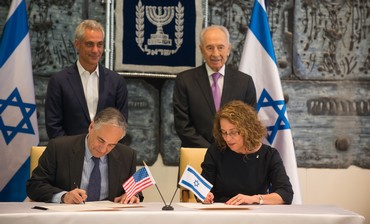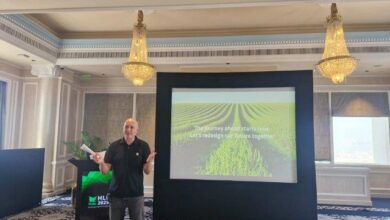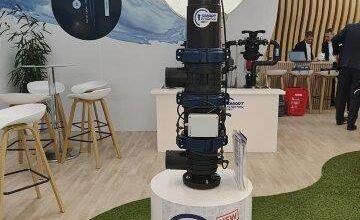Water Research Collaboration between BGU and Chicago University
Collaboration to foster water research at a molecular scale
SHARON UDASIN, GREER FAY CASHMAN

In an effort to develop less expensive and more efficient water resources throughout the world, the presidents of Ben-Gurion University of the Negev and the University of Chicago launched a collaboration program on Sunday that will foster water research at a molecular scale.
Ben-Gurion University president Rivka Carmi and University of Chicago president Robert Zimmer signed the agreement at the President’s Residence in Jerusalem. President Shimon Peres and Chicago Mayor Rahm Emanuel – the latter of whom spearheaded the initiative – attended the signing ceremony.
Joint activities between the two institutions may include the exchange of visiting faculty members, researchers and students, as well as the development of funding proposals for collaborative work and the generation of commercial technologies and business ventures, according to the universities.
“The scarcity of water is a source of political crises [and] uncontrolled immigration,” Carmi said at a press conference at the David Citadel Hotel following the ceremony.
“This is something central that the world is really looking at – providing inexpensive fresh water,” she continued.
“The idea to collaborate in a very big, very meaningful project was very appealing to us” Heading the partnership on the University of Chicago side will be Matthew Tirrell, the Pritzker director of the university’s Institute for Molecular Engineering, along with scientists from Argonne National Laboratory, which is managed jointly by the university and the US Department of Energy.
The Israeli team will be led by Moshe Gottlieb, BGU’s Frankel Professor of Chemical Engineering and the founder of the Ilse Katz Institute for Nanoscale Science and Technology.
Carmi and Zimmer on March 8 signed a memorandum of understanding in Chicago geared toward exploring the research partnership, but Carmi credited Emanuel as being “the spirit behind the whole initiative.”
“We want to do something big,” she said. “The fact that Mayor Emanuel had very big things on his mind as usual was very instrumental.”
The idea for the partnership began when Emanuel and Zimmer began discussing the idea of creating a water research collaboration with a major Israeli university about 18 months ago, the mayor explained at the press conference. Researchers at BGU, Emanuel continued, understand the importance of water as a commodity.
The resource is part of Chicago’s enormous infrastructure investment, one of the largest water and infrastructure investments in the United States, according to Emanuel. As the investment moves forward, 900 miles of water pipes will be replaced, 670 miles of sewer lines will be repaired or replaced, 160,000 separate catch basins will be totally rebuilt, two water treatment stations will be rebuilt and the pumping stations on Lake Michigan will also be rehabilitated. All in all, 18,000 people will work on these urban water projects over the next decade, and the repairs will be equivalent to saving two years worth of residential water, Emanuel explained. In its various “sister city” programs, Chicago includes water management as an integral component, he added.
“I want the city of Chicago to be at the epicenter of water conservation and engineering,” the mayor said, stressing that through the partnership with BGU, the University of Chicago will be able to bring the city to the forefront of research on a resource that has become scarce for the entire world.
“UChicago is on the shoreline of one of the largest fresh bodies of water in the world,” Emanuel said, noting that BGU, on the other hand, is in the middle of a desert.
“While totally different in environment, the missions are the same.”
The joint research projects will be based on “a web of collaborations” that is “anchored by this collaboration between Ben-Gurion University and the University of Chicago,” Zimmer said. Also critical will be the participation of the Argonne National Laboratory, which grew out of the World War II-era Manhattan Project and eventually became a multifaceted scientific laboratory.
Also joining the partners will be scientists from the Marine Biological Laboratory in Woodshole, Massachusetts, Zimmer added.
At the signing, Peres said, “It will be a service to humanity, to individuals and to future generations.”
Tirrell, the University of Chicago team leader, is also in the process of building his university’s first engineering program, and is making molecular engineering for water resources part of the core curriculum there.
“Not only is water a lifeessential molecule, but another thing that is getting increased attention is what’s coming to be called in the States the water-energy nexus, the idea that it takes energy to produce water and it takes water to produce energy,” Tirrell said.
Having visited Israel three times in the past seven months to hone initial project ideas, Tirrell observed that Israel has “a documented and longstanding ability to tackle” water problems, and is therefore an ideal partner.
One of the potential projects, which will involve principal investigators and students from each of the institutions, includes producing self-cleaning membranes that would typically build up bacterial films, Tirrell explained. Another project could include creating catalytic processes to remove organic wastes from industrial screens. Yet another could lead to tracing how water flows in groundwater to better understand contamination factors, he added.
Seed money is coming from the two universities and the Argonne Laboratory and thus far can support approximately five projects, Tirrell said.
“Together, we aim at translating molecular-level science into technological innovations,” added Gottlieb, the lead professor from the Israeli side. “We jointly have the skills, we have the expertise and with the proper resources we are certain that this partnership will bring about the timely solution of water problems that we are seeking.”
Jerusalem Post




